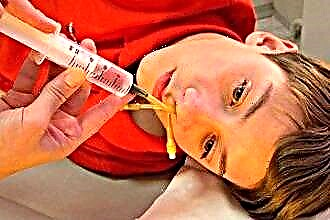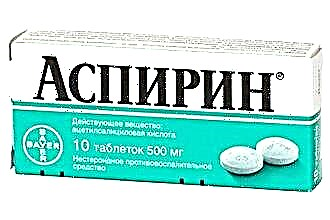Hyperthermia and inflammation of the laryngeal mucosa are clear signs of the development of an infectious disease. If the patient has a sore throat, painful swallowing and fever, it is necessary to find out the type of ENT disease and undergo appropriate treatment.
 As a rule, characteristic symptoms arise due to the development of bacterial or viral flora in the respiratory tract. An increase in temperature occurs as a result of activation of the body's defense mechanisms.
As a rule, characteristic symptoms arise due to the development of bacterial or viral flora in the respiratory tract. An increase in temperature occurs as a result of activation of the body's defense mechanisms.
It is worth noting that the normal temperature is considered to be 36.6-36.8, subfebrile - 37-38, febrile - 38-41, hyperthermic - over 41 degrees. Late intake of antipyretics, i.e. antipyretics, can cause heatstroke, febrile seizures in children and death in patients with cardiovascular pathologies.
Hyperthermia - Good or Bad?
Hyperthermia is a protective and adaptive reaction that occurs in response to the negative influence of pathogenic stimuli. The rise in temperature causes the tissues to warm up and the blood vessels to dilate, which puts excessive stress on the cardiovascular system. For this reason, it is recommended to strictly adhere to bed rest during the period of exacerbation of respiratory diseases.
The febrile state plays an important role in the process of destroying the pathogenic flora in the foci of inflammation. Hyperthermia contributes to:
- the creation of unfavorable conditions for the reproduction of pathogenic microorganisms in the foci of inflammation;
- intensive production of interferon, which prevents the development of pathogenic viruses;
- stimulation of defense mechanisms and an increase in local immunity.
Subfebrile and febrile fever leads to disruption of water-salt metabolism in tissues, which can cause dehydration.
Fever is often accompanied by loss of appetite and muscle weakness. Thus, the body "tries" to save energy by digesting food and supplying muscle tissue with nutrients. However, it should be borne in mind that severe intoxication caused by the accumulation of metabolites of pathogenic agents in the tissues only worsens the patient's well-being. To speed up the process of removing toxic substances from the blood, during the treatment of ENT pathology, it is necessary to consume at least 2 liters of warm drink per day.
Etiology
 The development of infectious diseases is facilitated by a sharp decrease in the body's resistance. Preschool children get sick more often than adults, which is due to the practical absence of specific (acquired) immunity. The reproduction of opportunistic microorganisms in the ENT organs can be provoked by:
The development of infectious diseases is facilitated by a sharp decrease in the body's resistance. Preschool children get sick more often than adults, which is due to the practical absence of specific (acquired) immunity. The reproduction of opportunistic microorganisms in the ENT organs can be provoked by:
- severe hypothermia;
- acclimatization;
- bad ecology;
- chronic diseases;
- hypovitaminosis;
- antibiotic abuse;
- secondary immunodeficiency;
- mechanical trauma to the mucous membranes of the throat;
- caries and stomatitis;
- chronic rhinitis;
- contact with infected patients.
To increase the general and local immunity of the child allows the intake of vitamin-mineral complexes and immunostimulants. However, drugs should only be prescribed by pediatricians due to the possible manifestation of adverse reactions.
Common ENT diseases
What to do if the throat hurts very badly, it hurts to swallow and there is a temperature? Clinical manifestations are not specific, therefore, it is possible to accurately determine the type of ENT disease only after passing an examination by a specialist. Typical symptoms may indicate the development of the following pathologies in children and adults:
- laryngitis;
- pharyngitis;
- epiglottitis;
- scarlet fever;
- tonsillitis;
 measles;
measles;- diphtheria;
- flu.
Symptomatic treatment with topical drugs eliminates the unpleasant manifestations of the disease, but does not destroy the pathogenic flora in the foci of inflammation.
Painful swallowing of saliva occurs due to inflammation of the mucous membranes in the throat.
In the process of swallowing, the muscles of the pharynx contract, as a result of which the epiglottis cartilage closes, which prevents the penetration of fluid into the trachea and lower respiratory tract. In the case of catarrhal or purulent tissue inflammation, patients feel pain in the throat.
Laryngitis
Laryngitis is an infectious inflammation of the mucous membrane and vocal cords in the larynx, which is most often promoted by hypothermia, overstrain of the pharynx, mechanical injury, inhalation of dusty air, etc. The development of pathology may be preceded by measles, pneumonia, tonsillitis, bacterial rhinitis or bronchitis. The main clinical manifestations of the disease include:
- sore throat;
- pain when swallowing saliva;
- hoarseness of voice;
- subfebrile fever;
- productive (wet) cough;
- muscle weakness;
- rhinitis.
Important! Overstrain of the vocal cords prevents recovery, therefore, during the period of acute inflammation of the ENT organs, the patient is not recommended to talk.
 The disease is especially dangerous for children under the age of 7-8 years, which is associated with the risk of false croup. Laryngeal edema and glottis spasms can cause hypoxia.
The disease is especially dangerous for children under the age of 7-8 years, which is associated with the risk of false croup. Laryngeal edema and glottis spasms can cause hypoxia.
Barking cough attacks interfere with normal breathing and gas exchange in tissues, which can lead to suffocation. In case of an attack it is necessary to call the ambulance team. With timely and adequate treatment of laryngitis, the inflammation disappears within 7-10 days. Ignoring the problem provokes complications and chronicity of pathological processes.
Patients with chronic laryngitis complain of rapid fatigue, hoarseness of the voice, "scratching" pain in the throat when swallowing, etc.
Pharyngitis
Pharyngitis is a viral disease characterized by inflammation of the lymphoid tissues and mucous membranes of the throat. The provocateurs of pathological processes are adenoviruses and rhinoviruses. In the absence of adequate therapy, microbes can join the viral flora, namely staphylococci, pneumococci, etc., which provoke purulent inflammation of the tissues of the lymphadenoid ring.
Clinical manifestations are largely determined by the nature of the ENT disease. In the case of the development of acute pharyngitis, children and adults complain about:
- subfebrile fever;
- dry, sore cough;
- pain when swallowing saliva;
- labored breathing;
- the presence of signs of intoxication.
A visual examination of the mucous membrane of the oropharynx reveals hyperemia (redness) of the lymphoid tissues, ulceration and swelling of the throat. In the case of the development of chronic pharyngitis, the symptoms are less pronounced. Patients may complain of hoarseness, sore throat, and occasional coughing. During an exacerbation of inflammation, the clinical manifestations of pathology are no different from the symptoms of acute pharyngitis.
Epiglottitis
 Epiglottitis is an inflammatory process in the epiglottis and the main parts of the pharynx, resulting from the development of bacteria such as hemophilus influenza. The disease most often occurs in children aged 2 to 5 years, however, in rare cases, the pathology is also diagnosed in adults. The danger of epiglottitis lies in the rapid development of pathological processes, as a result of which the following symptoms appear in patients for several hours:
Epiglottitis is an inflammatory process in the epiglottis and the main parts of the pharynx, resulting from the development of bacteria such as hemophilus influenza. The disease most often occurs in children aged 2 to 5 years, however, in rare cases, the pathology is also diagnosed in adults. The danger of epiglottitis lies in the rapid development of pathological processes, as a result of which the following symptoms appear in patients for several hours:
- fever;
- temperature increase;
- discomfort when swallowing;
- profuse salivation;
- labored breathing;
- dysphonia (nasal voice).
The penetration of viruses and bacteria into the submucous layer of the pharynx provokes tissue edema, as a result of which a narrowing of the lumen of the airways is observed.Due to the rupture of small blood capillaries, bloody impurities are found in saliva.
There are several main forms of epiglottitis:
- abscessed;
- edematous;
- infiltrative.
Delayed treatment of the disease in 10% of cases leads to the development of pneumonia and pericarditis.
The greatest danger to the child's health is represented by abscessing and infiltrative epiglottitis, which is associated with an increase in temperature to febrile levels, severe pain in the pharynx, a feeling of lack of air and swelling of the airways.
Tonsillitis
Tonsillitis or tonsillitis is an inflammatory process in lymphadenoid formations, i.e. palatine tonsils. The causative agents of infection are most often bacteria, in particular staphylococcus and beta-hemolytic streptococcus. Acute inflammation provokes an increase in temperature to febrile levels, which negatively affects the patient's well-being. At the initial stages of the development of the disease, patients complain of:
- burning sensation in the tonsils;
- hyperthermia;
- difficulty swallowing;
- dry cough;
- lack of appetite;
- myalgia;
- throat pain;
- nausea and vomiting;
- bad breath.
There are several main forms of tonsillitis, each of which is characterized by the manifestation of certain symptoms:
Hyperthermia with tonsillitis
| Type of tonsillitis | Clinical manifestations | Body temperature indicators |
| catarrhal | hyperemia of the pharynx and palatine tonsils, painful swallowing of saliva, enlargement of regional lymph nodes | 37-38 |
| follicular | accumulation of purulent masses in the follicles (white streaks on the tonsils), pain when swallowing, radiating to the ears | up to 38.5-39 |
| lacunar | white bloom on the root of the tongue and throat, yellowish plugs in the palatine lacunae (tonsillolitis) | 39-40 |
| phlegmous | throat pain, increased salivation, enlargement of one or both palatine tonsils | 39-40 |
| fibrous | white film on the surface of the tonsils, pain in the head and throat | 38.5-40 |
| ulcerative necrotic | a slight increase in one of the tonsils, ulceration of the pharyngeal mucosa, gray plaque on the tonsils | 37-38 |
In young children, angina often occurs against the background of the development of scarlet fever, in which redness occurs on the pharynx and pharynx. Hyperemia of the mucous membranes and acute inflammation of the lymphoid tissues cause severe pain when swallowing saliva and talking.
Important! The development of scarlet fever is signaled by a small rash that occurs on the skin.
Measles
 Measles is a highly contagious viral disease characterized by inflammation of the airways, febrile fever, conjunctivitis, and papular skin rashes. Infectious pathology most often occurs in children under 5 years of age and is one of the most formidable childhood diseases.
Measles is a highly contagious viral disease characterized by inflammation of the airways, febrile fever, conjunctivitis, and papular skin rashes. Infectious pathology most often occurs in children under 5 years of age and is one of the most formidable childhood diseases.
According to the WHO, at least 150 thousand people die from measles every year, most of whom are preschool children. The causative agent of the infection is an RNA virus, which is transmitted by airborne droplets. In 95% of cases, the disease is diagnosed in children aged 2 to 5 years.
The peculiarity of the pathology lies in the fact that the pathogenic flora, penetrating the airways and, accordingly, the blood, affects absolutely all types of white immunocompetent cells.
The incubation period for the development of the RNA virus is on average 8-10 days. Infection of the ENT organs is most often indicated by the following symptoms:
- high temperature (39-40 degrees);
- severe runny nose;
- measles enanthem;
- discomfort when swallowing;
- headache;
- photophobia;
- hoarseness of the voice;
- hyperemia of the pharynx;
- constant sneezing.
Approximately on the 4-5th day of the development of the disease, the child develops measles exanthema, i.e. papular skin rash. If you experience characteristic symptoms, you need to seek help from a pediatrician.
 Delayed therapy can cause serious complications, in particular lymphadenitis and measles encephalitis.
Delayed therapy can cause serious complications, in particular lymphadenitis and measles encephalitis.
Inadequate treatment of measles provokes malfunctioning of the central nervous system and stenosis of the larynx.
Adults who have not had measles in childhood are difficult to tolerate the disease. Patients complain of general fatigue, shortness of breath, febrile fever, and severe pain in the throat. Often in adults, complications arise in the form of bacterial inflammation of the oropharynx and measles pneumonia.
Flu
Influenza is a respiratory disease in which there is catarrhal inflammation of the airways. Absolutely all categories of people are predisposed to viral pathology, so not only children, but also adults can get sick with the flu. The entrance gate for viral infection is the mucous membranes of the bronchi, mouth, nose and trachea. The infection quickly penetrates the cells of the ciliated epithelium, provoking inflammation and swelling of the tissues.
Flu symptoms are not specific, so it is almost impossible to accurately determine the type of respiratory disease without laboratory tests.
The severity of the pathology can range from mild to hypertoxic, which is most common in young children. The development of a typical influenza infection is indicated by the following clinical manifestations:
- fever;
- myalgia;
- chills;
- fatigue;
- runny nose;
- sore throat;
- discomfort when swallowing;
 heat;
heat;- dry, spasmodic cough.
Severe flu is fraught with the development of vascular collapse, which can cause brain inflammation.
Moderately severe forms of ENT disease can cause serious systemic and local complications, which is associated with the peculiarities of the course of pathological processes in the body. A viral infection has a pronounced capillarotoxic effect, as a result of which a decrease in tissue reactivity is observed.
Diphtheria
Diphtheria is a bacterial inflammation of the mucous membranes of the oropharynx, bronchi and larynx. The severity of the pathology is largely due to the accumulation of an excessive amount of toxic substances in the tissues, which are secreted by the diphtheria bacillus. If the pathogenic flora affects not only the oropharynx, but also the airways, in addition to general intoxication, the development of pharyngeal stenosis is not excluded, in which there is a narrowing of the airway lumen.
Diphtheria croup is a common form of ENT disease, which is characterized by a predominant lesion of the laryngeal mucosa. The bacterial flora is localized in the larynx, trachea and bronchi, as a result of which there is swelling of the mucous membranes of the ENT organs. As a rule, the disease is accompanied by the following clinical manifestations:
- heat;
- muscle weakness;
- an increase in the palatine tonsils;
- a filmy coating on the throat;
- difficulty swallowing;
- sore throat;
- an increase in regional lymph nodes.
Toxic and hypertoxic diphtheria requires immediate medical treatment. In preschool children, the disease causes febrile convulsions, loss of consciousness, the formation of a hemorrhagic rash on the skin, etc. In the case of an increase in cardiovascular insufficiency due to capillary collapse, death occurs approximately 3-4 days after the onset of severe symptoms.
Features of pharmacotherapy

Treatment of ENT diseases can only be prescribed by a qualified specialist after an accurate diagnosis. Palliative (symptomatic) therapy is aimed only at relieving the symptoms of the disease. To eliminate the cause of the problem, it is necessary to undergo a course of antibacterial or antiviral therapy with the use of pathogenetic drugs.
The scheme of complex treatment of infectious diseases accompanied by discomfort in the throat and hyperthermia includes the following types of medications:
- antibiotics - "Augmentit", "Amoxiclav", "Erythromycin", "Cephalexin";
- antiviral agents - "Arbidol", "Ingavirin", "Amiksin", "Arpeflu";
- anti-inflammatory drugs - "Ketorol", "Aertal", "Nurofen", "Diklonak";
- antiseptics for throat sanitation - Angilex, Chlorhexidine, Rekutan, Hepilor;
- throat irrigation sprays - Ingalipt, Stopangin, Cameton, Teraflu;
- lozenges - "Travisil", "Septolete", "Grammidin", "Faringosept";
- throat lubricants - "Carotolin", "Lugol's solution", "Lugs", "Yoks".
If a child or an adult has a fever, you can use antipyretics: Coldact, Paracetamol, Panadol, Efferalgan, etc. People suffering from liver failure need to use hepatoprotectors in parallel. They prevent the creation of excessive loads on the detoxification organs, thereby reducing the likelihood of drug poisoning in the body.

 measles;
measles; heat;
heat;

